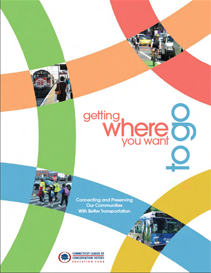
Adding to the recent string of good news for sustainable transportation advocates in the Nutmeg State, the Connecticut League of Conservation Voters Education Fund recently released a new guide to transportation in the state. It offers a crash course in how (and why) the state must continue improving its transportation network, describing the current system’s negative impacts on public health, the environment, and Connecticut citizens’ wallets. The guide is also packed with useful facts that shed light on the consequences of infrastructure that prioritizes automobile use over a more multi-modal system: congestion that cost the Bridgeport-Stamford area $441 million annually; transportation sources that are responsible for 43% of Connecticut’s air pollutants; 52,000 gallons of polluted, gasoline-infused runoff that results when an inch of rain falls on a mile of a two-lane paved road.
These stark truths lend urgency to the CTLCV Education Fund’s thoughtful policy recommendations:
- Develop a coordinated plan for a balanced, inter-modal transportation system;
- Adopt policies to shift trips from single-occupancy vehicles to alternative modes;
- Support transit-oriented development;
- Implement green infrastructure best practices;
- Fix-it-first;
- Develop stable sources of funding for transportation;
- Make walking and biking easier and safer with low-cost and small-scale improvements;
- Improve and expand bus transit while holding the line on the fares;
- Invest in rail;
- Incentivize clean fuel options.
In the document, each of the recommendations is fully fleshed out, and the organization makes several bold suggestions. The guide says that Connecticut should “develop a state-wide Transit Oriented Development (TOD) plan and a policy with interagency collaboration,” “dedicate an equitable and predictable funding stream for bike and pedestrian programs,” “dedicate existing highway lanes for buses only,” and more.
In an indication that both ConnDOT Commissioner James Redeker and Department of Energy and Environmental Protection Commissioner Daniel Esty have begun to understand the need to prioritize sustainable transportation policy, both praised the guide upon its release. To read the full document, click here.
